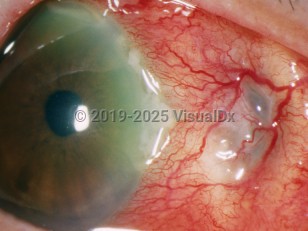Necrotizing scleritis - External and Internal Eye
Alerts and Notices
Important News & Links
Synopsis

Necrotizing scleritis typically causes severe injection and pain in a patch of the sclera. With progressive disease, the sclera will necrose, leaving only a white patch of thin sclera surrounded by red, inflamed blood vessels. As the sclera thins, the blue color of the underlying uveal blood vessels becomes visible (blue sclera), and, at times, the intraocular pressure can cause an out-pouching of an area of the sclera.
Rarely, necrotizing scleritis can occur without pain and injection and may lead to ocular perforation. This form of necrotizing scleritis is called scleromalacia perforans.
Necrotizing scleritis is most commonly seen in middle-aged women with rheumatologic disease and is associated with worsening vasculitis. As with other forms of scleritis, there is a tendency for both eyes to be affected, although the disease may progress differently in each eye and at different rates.
Ocular or extraocular complications (including premature death) will be seen in over 50% of patients with necrotizing scleritis.
Codes
H15.093 – Other scleritis, bilateral
SNOMEDCT:
95797003 – Necrotizing scleritis
Look For
Subscription Required
Diagnostic Pearls
Subscription Required
Differential Diagnosis & Pitfalls

Subscription Required
Best Tests
Subscription Required
Management Pearls
Subscription Required
Therapy
Subscription Required
Drug Reaction Data
Subscription Required
References
Subscription Required
Last Updated:03/21/2021

